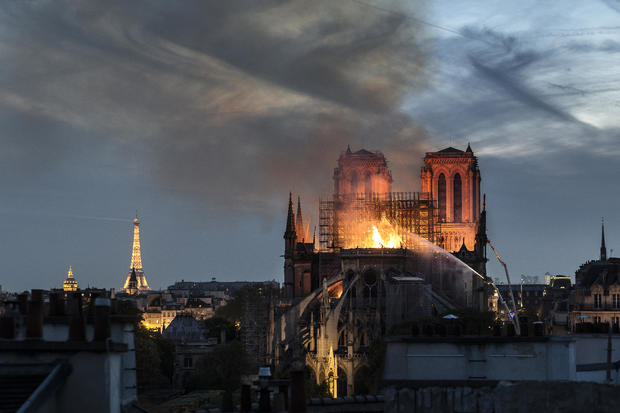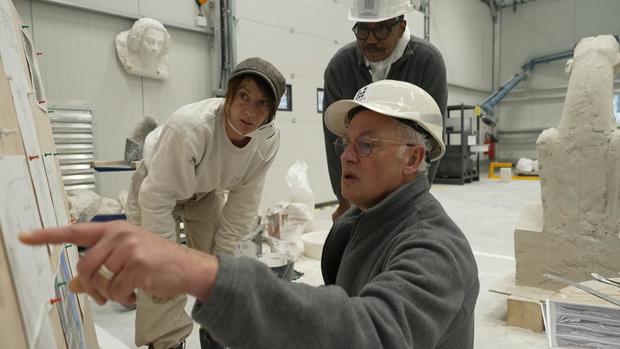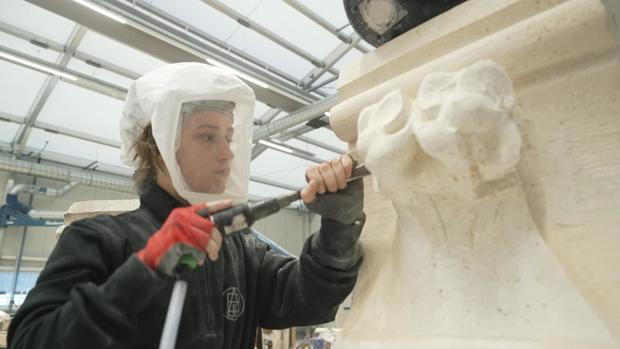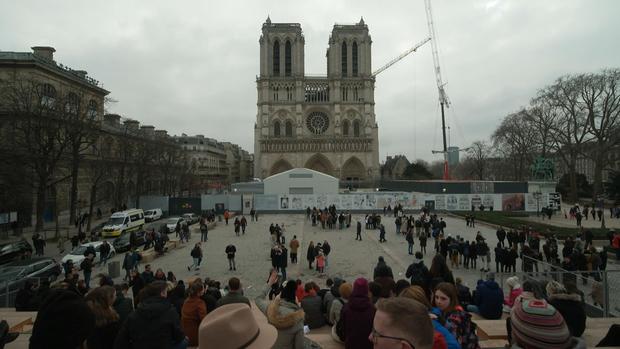This is an updated version of a story first published on April 9, 2023. The original video can be viewed here.
When the Cathedral of Notre Dame in Paris caught fire in April 2019, it was one of those moments that people around the world experienced together, staring in horror at live video on their smartphones and televisions.
For the people of France, it was especially traumatic, because Notre Dame has been a powerful symbol since medieval times.
French President Emmanuel Macron immediately pledged that Notre Dame would be reopened by the end of 2024. It seemed at the time to be an unrealistic promise. But as we first reported in April, the resurrection of the great cathedral now seems within reach.
Flames tore through the roof of Notre Dame on the evening of April 15th, 2019, and spread with incredible speed and ferocity engulfing her 200-foot spire.
General Jean-Louis Georgelin: Everybody stops.
Jean-Louis Georgelin is the man now in charge of restoring Notre Dame.
General Jean-Louis Georgelin: And a lot of people in France cried because they feel that something very deep in the soul of France and the spirit of France was about to collapse.
Only a heroic effort by the Paris Fire Brigade saved Notre Dame from collapse, as a few staffers raced through falling embers to rescue precious relics. Philippe Villeneuve, the cathedral’s chief architect, was out of town that night, and raced back to Paris. He was devastated by what he saw.
Philippe Villeneuve (translation): I’ve said that the little boy who was in love with the cathedral, and the architect who was in charge of it died that day, and another man took over, and said ‘I have to save the cathedral. It’s my mission. It’s my duty.’
Villeneuve now shares that duty. If he’s the artist who knows every inch of stone in Notre Dame, retired army General Georgelin is the commander – called back to meet that five-year deadline.
General Jean-Louis Georgelin: I will relax only when this will be done.
Bill Whitaker: What does this cathedral mean to the people of France?
General Jean-Louis Georgelin: The Cathédrale Notre-Dame de Paris is, in some way, the heart of France. For the Catholic, of course, for the Christian, but for everybody. All the great events of France, in some way or another, took place here in the cathedral.
Napoleon crowned himself emperor in Notre Dame in 1804. In 1944, as Paris was liberated from Nazi occupation, General Charles de Gaulle braved sniper fire to enter the cathedral.
Agnes Poirier: In many ways, you could say that she’s the people’s palace.
Agnes Poirier is a journalist and author who lives and works just across the River Seine from Notre Dame. She and her neighbors watched the most horrifying moment the night of the fire, the collapse of that imposing spire.
Agnes Poirier: I remember the scream of the crowd saying, ‘No,’ as if they couldn’t– they couldn’t –conceive– such a thing.
That spire meant so much to Philippe Villeneuve that he had it tattooed on his arm.
Philippe Villeneuve (translation): They say that I have Notre Dame in my skin. It’s very practical, because when I have to explain how the spire fell, it’s always better to show that from here to there it tipped over.
The huge spire, made of oak and covered in lead tiles, crashed through two of the stone vaults which form the ceiling of Notre Dame, leaving gaping holes at the top and heaps of broken stone and charred wood on the floor below.
The top priority was to shore up the grand cathedral’s weakened structure. Huge temporary wooden supports were placed under the surviving stone vaults of her ceiling, and under the flying buttresses to save this prime example of medieval engineering.
General Jean-Louis Georgelin: We have to check every stone in the cathedral, every pillar.
At the same time, a huge decontamination project was mounted, to remove lead tiles that had melted from the burning roof and spire, and all the toxic lead dust spread by the fire.
Four years on, workers still take extraordinary precautions against lead poisoning. We had to wear disposable hazmat suits to enter the cathedral.
Tons of rubble had to be removed, paintings and stained glass windows were taken away for restoration, and twisted steel scaffolding erected for ongoing restoration work had to be dismantled.
Bill Whitaker: So you were in the process of restoring the spire when the fire broke out in 2019. Did your restoration project have anything to do with the fire breaking out?
Philippe Villeneuve (translation): An investigation is still underway. And no cause of the fire has been identified. But personally, it’s unbearable. this fire never should have happened, and it did. Inevitably, I feel responsible.
Philippe Villeneuve: So you know…
At that point in our interview, Villeneuve switched to English with a rueful smile.
Philippe Villeneuve: In reality, I’m totally destroyed.
Bill Whitaker: Really?
Philippe Villeneuve: Yes. I so want to rebuild Notre Dame, it’s because I want to rebuild myself.
The fire’s deeply emotional impact on Philippe Villeneuve was mirrored around the world. Nearly a billion dollars in private donations have been pledged to rebuild Notre Dame, most of it from France … $50 million from Americans.
Bill Whitaker: I know many people in the United States contributed.
General Jean-Louis Georgelin: They can contribute again.
Bill Whitaker: They can continue to contribute, huh?
General Jean-Louis Georgelin: Yeah. The cash is always running, if they want to give me money I need.
In the weeks immediately following the fire, all sorts of ideas were floated for how centuries-old Notre Dame might be given a touch of avant-garde.
Agnes Poirier: And all those architects throughout the world said, ‘Yes, let’s have a roof garden. Let’s have a golden torch. Let’s have a titanium– spire.’ You know, even I, for 20 seconds, I thought, ‘Hmm. To add some 21st century genius to Notre Dame, why not?’
Chief architect Philippe Villeneuve had a very simple answer why not:
Philippe Villeneuve (translation): An historic monument, a cathedral, is not something to be played with. Notre Dame had been standing for 850 years with a wooden frame and a lead roof. So wood is the way to go!
In the end, President Macron and a special committee agreed to rebuild Notre Dame exactly as she had been, and with the same materials: stone, wood, and lead.
Bill Whitaker: How is it that the traditionalists won out?
Agnes Poirier: Well, I think wisdom won.
Notre Dame’s signature spire was a fairly recent addition. Images of the cathedral from the mid 1800’s show her without a spire, and in an advanced state of decay.
Bill Whitaker: The cathedral was in great disrepair, was it not?
Agnes Poirier: It was about to collapse, but of neglect, not of fire.
There were even proposals to demolish Notre Dame before the cathedral crumbled on its own. Instead, the French government hired a young architect named Viollet-le-Duc. He created that famous spire.
Bill Whitaker: So you are rebuilding the spire exactly as Viollet-le-Duc?
Philippe Villeneuve: Yes.
Bill Whitaker: Are you using his original drawings?
Philippe Villeneuve (translation): We were lucky because it was extremely well-documented. We have the drawings of Violett-le-Duc, the sketches, the surveys, we have everything needed to be able to remake it.
A thousand French oak trees were felled for the new spire, then fine-cut by carpenters in eastern France. In other workshops around the country, the cathedral’s organ, the largest in France, and many of its stained glass windows were restored.
Bill Whitaker: How many workers and craftsmen do you have on this project?
General Jean-Louis Georgelin: If we take into account all the people in France, it’s about 1,000 people.
On the plaza in front of Notre Dame, a huge tent has been erected where stone cutters and sculptors are recreating gothic gargoyles and adornments damaged in the fire. Philippe Villeneuve supervises every detail.
Philippe Villeneuve (translation): I’ll make them put their fingers on the layers of the original sculpture. And then on the layer they are sculpting.
Bill Whitaker: So you he wants you to feel it, not just look at it?
Danae Leblond: Yeah. Yeah. Yeah.
Bill Whitaker: And that works?
Danae Leblond: Yeah. I think– I think so.
Danae Leblond is just 23 years old, sculpting and chiseling to recreate a floral detail carved hundreds of years ago.
Danae Leblond (translation): We try to remake things identically. But we are also trying to understand the intention of the original sculptors, so we look at the traces left by their tools.
We were given rare access to the painstaking restoration of Notre Dame, as workers and artisans revived the cathedral’s exterior…
…and her interior.
The cathedral’s great rose windows have been meticulously cleaned, and every inch of stone coated with latex, which when peeled away leaves the surface gleaming. We found restorers Mathilde Maire and Aude Massimi working on painted stone sculptures depicting scenes from the life of Christ.
Bill Whitaker: How old is this?
Mathilde Maire (translation): This part of the cathedral was built at the beginning of the 14th Century. These sculptures are medieval.
The restorers are carefully wiping every surface with small cotton swabs dipped in a water-based cleaning solution.
Bill Whitaker: So I think you have to have a lot of patience.
Mathilde Maire: Yes, Oui.
Mathilde Maire (translation): Yes. You have to be calm and know that it will take time, but it’s a pleasure.
Bill Whitaker: We can see she’s wiping away the centuries.
A 600-ton maze of scaffolding has been built inside Notre Dame to support all the work, especially the rebuilding of the spire. General Georgelin took us up through it… two-thirds of the way on a construction elevator. We reached the top climbing steps and ladders.
We were standing 100 feet above the cathedral floor, in exactly the spot where the flaming spire collapsed… four years ago there was nothing here but a vast hole.
General Jean-Louis Georgelin: The drama took place here. And we have to rebuild the vault of the transept. The spire will be there, 66 meters high.
At the top of the old 200-foot spire sat a copper sculpture of a rooster – the symbol of the French people. The day after the fire, Philippe Villeneuve found it on a lower roof, a bit mangled, but miraculously, untouched by the flames. It has been left as it was found, and will be put on display in the restored cathedral.
Philippe Villeneuve (translation): Can I tell you that I plan to put a new rooster on top of a new spire one year to the day before the reopening of the cathedral. There will still be scaffolding, but the frame of the spire will again be in the sky of Paris.
General Jean-Louis Georgelin: And the spire will–rest, reposer, rest on these four pillars you see here, you see?
Bill Whitaker: Be magnificent?
General Jean-Louis Georgelin: Magnificent, yes, for the glory of God and France.
General Jean-Louis Georgelin, who led the effort to reconstruct Notre Dame for more than four years, died 10 days ago while hiking in the French Pyrenees. He was 74.
French President Emmanuel Macron tweeted that France had lost “one of its great servants and Notre-Dame the master manager of its renaissance,” and pledged to carry on the general’s mission to have the great cathedral reopened by the end of next year.





